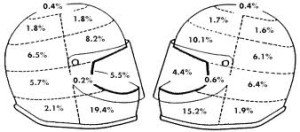 In 2005 Journalist Dexter Ford caused a controversy in the motorcycle world with an outstanding piece of investigative journalism published in Motorcyclist Magazine. Called Blowing the Lid Off, Ford found that some low price DOT approved helmets offered more protection against severe head injury than expensive Snell Certified helmets constructed from state of the art materials. During his six months of research on the article, these findings were corroborated by doctors and scientists. They were also promptly refuted by many helmet manufacturers and the Snell Foundation itself.
While I don’t know much about helmet manufacturing or neurology, I do have some first hand experience with head injuries. I’m a four-time loser when it comes to concussions. One from a motorcycle accident, one compliments of a skateboard crash, and two from my years spent cart wheeling down mountains on a snowboard.
The worst of these left me drooling on the couch for a solid week. My thought process was so slow during this time, I could barely comprehend daytime television. The Price is Right seemed like a dizzying foray into the world of high finance. The Maury Povich Show seemed like Shakespearean Tragedy. The Roadrunner cartoons simply had too many plot twists for me to grasp. Eventually I discovered that my comprehension level had regressed so much, the only thing I could follow was The Real World on MTV.
There were other fun consequences as well; nausea, vomiting, tunnel vision, temporary loss of vision in my left eye, and one of the most unnerving experiences in my life; I had a severe sensation of Deja vu all day everyday, for weeks afterward. Maybe I was stuck on the couch for too many days. Maybe my life had become as predictable as MTV’s insipid reality show.
Eventually I made a full recovery and I returned to my normal intellectual level – that of a 14-year-old boy. All these experiences led me to the brilliant conclusion that I should probably try to avoid head injuries. I thought the best way to do that, other than rolling myself up in bubble wrap and hiding in a closet, was to wear an expensive high quality helmet.
There are some things I never want to get at a bargain price. A tattoo for example. Or an appendectomy. I’ve also applied this wisdom when it comes to purchasing a motorcycle helmet. Spend the money and buy a quality product. After all, it’s the only line of defense my head has against asphalt, cars, trees, rocks, and the occasional mule deer. Next time I knock myself silly I’d rather not end up in a state hospital believing that I’m a glass of orange juice.
So I always assumed that the more exotic the material, the more elaborate its construction, and the higher the certification, the better the protection. In case anyone is unfamiliar with helmet certifications, I’ll summarize them as best as someone who’s drop checked his head four times can.
The base line standard for any motorcycle helmet to be sold legally in the United States is DOT Approved. Yes DOT stands for Department of Transportation, that wonderful branch of the federal government.
I say legally because Harley riders can still purchase a ‘novelty’ helmet that resembles a cereal bowl and put their own ‘DOT’ sticker on the back of it. These helmets offer slightly more protection than a Yarmulke and are a fine example of natural selection at work. It’s basically the equivalent of buying a 3 foot Bong ‘for tobacco use only’, and every time I see someone wearing one of these skull caps I assume they’ve used their 3 foot bong for more than tobacco before choosing a novelty helmet to protect their head.
Snell certification means that the helmet has been held to more stringent standards by the Snell Memorial Foundation, a private sector not-for-profit organization. Snell certified helmets must be able to absorb a higher level of force from an impact – uh, correction – impacts. That means these helmets are designed to allow the user to hit their head really hard twice in the same place.
So what’s the problem? Private foundation with higher standards versus low tech government issue seems like an easy choice to make. The problem lies (literally) in your head. The stiffer materials needed to achieve Snell certification can transfer more of the G force from the most common motorcycle accidents to your brain. Meaning the high dollar helmet you bought may protect your skull but allows less of the force to be absorbed by its material, causing your brain to ricochet off the inside of your head.
Enter another controversy. The ‘most common motorcycle accidents’ for this particular article is defined by something called The Hurt Report, a one year study of motorcycle accidents and fatalities done by Dr Harry Hurt in 1976 and published in 1981. Dr Hurt studied over 900 motorcycle accidents in and around the Los Angeles area for over a year, compiling a large amount of data and eventually coming up with some common denominators, including:
In 2005 Journalist Dexter Ford caused a controversy in the motorcycle world with an outstanding piece of investigative journalism published in Motorcyclist Magazine. Called Blowing the Lid Off, Ford found that some low price DOT approved helmets offered more protection against severe head injury than expensive Snell Certified helmets constructed from state of the art materials. During his six months of research on the article, these findings were corroborated by doctors and scientists. They were also promptly refuted by many helmet manufacturers and the Snell Foundation itself.
While I don’t know much about helmet manufacturing or neurology, I do have some first hand experience with head injuries. I’m a four-time loser when it comes to concussions. One from a motorcycle accident, one compliments of a skateboard crash, and two from my years spent cart wheeling down mountains on a snowboard.
The worst of these left me drooling on the couch for a solid week. My thought process was so slow during this time, I could barely comprehend daytime television. The Price is Right seemed like a dizzying foray into the world of high finance. The Maury Povich Show seemed like Shakespearean Tragedy. The Roadrunner cartoons simply had too many plot twists for me to grasp. Eventually I discovered that my comprehension level had regressed so much, the only thing I could follow was The Real World on MTV.
There were other fun consequences as well; nausea, vomiting, tunnel vision, temporary loss of vision in my left eye, and one of the most unnerving experiences in my life; I had a severe sensation of Deja vu all day everyday, for weeks afterward. Maybe I was stuck on the couch for too many days. Maybe my life had become as predictable as MTV’s insipid reality show.
Eventually I made a full recovery and I returned to my normal intellectual level – that of a 14-year-old boy. All these experiences led me to the brilliant conclusion that I should probably try to avoid head injuries. I thought the best way to do that, other than rolling myself up in bubble wrap and hiding in a closet, was to wear an expensive high quality helmet.
There are some things I never want to get at a bargain price. A tattoo for example. Or an appendectomy. I’ve also applied this wisdom when it comes to purchasing a motorcycle helmet. Spend the money and buy a quality product. After all, it’s the only line of defense my head has against asphalt, cars, trees, rocks, and the occasional mule deer. Next time I knock myself silly I’d rather not end up in a state hospital believing that I’m a glass of orange juice.
So I always assumed that the more exotic the material, the more elaborate its construction, and the higher the certification, the better the protection. In case anyone is unfamiliar with helmet certifications, I’ll summarize them as best as someone who’s drop checked his head four times can.
The base line standard for any motorcycle helmet to be sold legally in the United States is DOT Approved. Yes DOT stands for Department of Transportation, that wonderful branch of the federal government.
I say legally because Harley riders can still purchase a ‘novelty’ helmet that resembles a cereal bowl and put their own ‘DOT’ sticker on the back of it. These helmets offer slightly more protection than a Yarmulke and are a fine example of natural selection at work. It’s basically the equivalent of buying a 3 foot Bong ‘for tobacco use only’, and every time I see someone wearing one of these skull caps I assume they’ve used their 3 foot bong for more than tobacco before choosing a novelty helmet to protect their head.
Snell certification means that the helmet has been held to more stringent standards by the Snell Memorial Foundation, a private sector not-for-profit organization. Snell certified helmets must be able to absorb a higher level of force from an impact – uh, correction – impacts. That means these helmets are designed to allow the user to hit their head really hard twice in the same place.
So what’s the problem? Private foundation with higher standards versus low tech government issue seems like an easy choice to make. The problem lies (literally) in your head. The stiffer materials needed to achieve Snell certification can transfer more of the G force from the most common motorcycle accidents to your brain. Meaning the high dollar helmet you bought may protect your skull but allows less of the force to be absorbed by its material, causing your brain to ricochet off the inside of your head.
Enter another controversy. The ‘most common motorcycle accidents’ for this particular article is defined by something called The Hurt Report, a one year study of motorcycle accidents and fatalities done by Dr Harry Hurt in 1976 and published in 1981. Dr Hurt studied over 900 motorcycle accidents in and around the Los Angeles area for over a year, compiling a large amount of data and eventually coming up with some common denominators, including: 75% of these accidents involved a collision with another vehicle, mainly cars. The most likely place for an accident is at an intersection and is caused by a motorist’s failure to see the motorcycle and violating its right-of-way. Many of the fatalities were related to the motorcyclist hitting his head on the asphalt. While all of this seems like common sense, the real surprise was the median crash speed – 21.5 MPH. That’s only 2nd gear for me.
The reason why this study remains controversial is that many people argue it’s old and outdated. Technologies have changed since then. Bikes are faster and lighter but also have better brakes and handling. Helmets have improved. Many variables have evolved, but I have a hard time believing that slamming your skull on the asphalt at 20 MPH has changed much.
Since this is a Dual Sport site it can also be argued that The Hurt Report is indicative of street bike accidents and can’t be applied to off-road bikes. But Dual Sport motorcycles do ride on the road (hence the name) and most accidents occur within a mile or two from home. For myself, every time I ride on trails I think about possibly breaking a bone. But every time I ride on the street I think about being punted into the stratosphere by some soccer mom texting-while-driving her tawdry Escalade. So far I’ve been lucky, the near misses I’ve had with automobiles have only resulted in soiled underwear.
Back to the matter at hand, I found the information in Ford’s article to be surprising. Even more surprising was the fact that I’m not the last person on the planet to know about this; all but one of the riders I mentioned it to were unaware of it. I was also surprised by some of the responses I got when I did mention it.
The first person I told scoffed before I even finished my first sentence. He said he had heard this issue discussed before and hated cheap helmets because they didn’t fit comfortably, tended to have poor ventilation, and the inside liners didn’t hold up. This is a valid point, but going back to the aforementioned concussions I’ve suffered, safety is my first priority. Plus not everyone’s head is the same; some people have nice symmetrical heads, others are shaped more like a Yeti. Comfortable fit can be a relative term.
The next rider I mentioned it to was an avid sport bike rider. His initial reaction was also negative, the major complaint being that bargain helmets let too much wind noise in and it was hard to hear his ipod. In fact, of all the riders I talked to about this, only one mentioned safety and protection as top priority. It made me wonder how many riders even pay attention to helmet certifications.
Ford’s article certainly got the Snell Foundation’s immediate attention. They, along with several helmet manufacturers, were rather peeved to say the least. But eventually the Foundation answered some of the criticisms about their (M2005) standard with a new (M2010) standard.
So if all this happened years ago and Snell has a new and improved standard, is this still relevant? As I mentioned, its seems there’s a lot of riders who are unaware of this. They might feel inclined (as I did) to shell out more money for a Snell certified helmet with the belief they are getting a product that offers superior protection. Another reason this remains relevant is that Snell allowed manufacturers to make helmets to the now-superseded M2005 standard until March of 2012 – and sell them forever.
On a sad note, this article resulted in two prominent helmet manufacturers yanking their ad dollars from Motorcyclist Magazine. For his hard work and contribution to motorcycling safety Dexter Ford was rewarded with a pink slip from the job he held for 30 years. In my opinion, what should have been a boon for the magazine ended up as a black eye.
While this article did cost him his job at the time, maybe it ended up saving someone’s life. I know at the very least, it will end up saving me some money. Next time I go helmet shopping if I have a choice between an expensive Snell certified helmet constructed from Millennium Falcon parts or a reasonably priced DOT approved helmet that’s comfortable, I’m picking the cheaper one.
For me that’s a no-brainer.
CHECK OUT DEXTER FORD’S IN DEPTH ARTICLE HERE – IT’S WORTH THE READ!
75% of these accidents involved a collision with another vehicle, mainly cars. The most likely place for an accident is at an intersection and is caused by a motorist’s failure to see the motorcycle and violating its right-of-way. Many of the fatalities were related to the motorcyclist hitting his head on the asphalt. While all of this seems like common sense, the real surprise was the median crash speed – 21.5 MPH. That’s only 2nd gear for me.
The reason why this study remains controversial is that many people argue it’s old and outdated. Technologies have changed since then. Bikes are faster and lighter but also have better brakes and handling. Helmets have improved. Many variables have evolved, but I have a hard time believing that slamming your skull on the asphalt at 20 MPH has changed much.
Since this is a Dual Sport site it can also be argued that The Hurt Report is indicative of street bike accidents and can’t be applied to off-road bikes. But Dual Sport motorcycles do ride on the road (hence the name) and most accidents occur within a mile or two from home. For myself, every time I ride on trails I think about possibly breaking a bone. But every time I ride on the street I think about being punted into the stratosphere by some soccer mom texting-while-driving her tawdry Escalade. So far I’ve been lucky, the near misses I’ve had with automobiles have only resulted in soiled underwear.
Back to the matter at hand, I found the information in Ford’s article to be surprising. Even more surprising was the fact that I’m not the last person on the planet to know about this; all but one of the riders I mentioned it to were unaware of it. I was also surprised by some of the responses I got when I did mention it.
The first person I told scoffed before I even finished my first sentence. He said he had heard this issue discussed before and hated cheap helmets because they didn’t fit comfortably, tended to have poor ventilation, and the inside liners didn’t hold up. This is a valid point, but going back to the aforementioned concussions I’ve suffered, safety is my first priority. Plus not everyone’s head is the same; some people have nice symmetrical heads, others are shaped more like a Yeti. Comfortable fit can be a relative term.
The next rider I mentioned it to was an avid sport bike rider. His initial reaction was also negative, the major complaint being that bargain helmets let too much wind noise in and it was hard to hear his ipod. In fact, of all the riders I talked to about this, only one mentioned safety and protection as top priority. It made me wonder how many riders even pay attention to helmet certifications.
Ford’s article certainly got the Snell Foundation’s immediate attention. They, along with several helmet manufacturers, were rather peeved to say the least. But eventually the Foundation answered some of the criticisms about their (M2005) standard with a new (M2010) standard.
So if all this happened years ago and Snell has a new and improved standard, is this still relevant? As I mentioned, its seems there’s a lot of riders who are unaware of this. They might feel inclined (as I did) to shell out more money for a Snell certified helmet with the belief they are getting a product that offers superior protection. Another reason this remains relevant is that Snell allowed manufacturers to make helmets to the now-superseded M2005 standard until March of 2012 – and sell them forever.
On a sad note, this article resulted in two prominent helmet manufacturers yanking their ad dollars from Motorcyclist Magazine. For his hard work and contribution to motorcycling safety Dexter Ford was rewarded with a pink slip from the job he held for 30 years. In my opinion, what should have been a boon for the magazine ended up as a black eye.
While this article did cost him his job at the time, maybe it ended up saving someone’s life. I know at the very least, it will end up saving me some money. Next time I go helmet shopping if I have a choice between an expensive Snell certified helmet constructed from Millennium Falcon parts or a reasonably priced DOT approved helmet that’s comfortable, I’m picking the cheaper one.
For me that’s a no-brainer.
CHECK OUT DEXTER FORD’S IN DEPTH ARTICLE HERE – IT’S WORTH THE READ!






